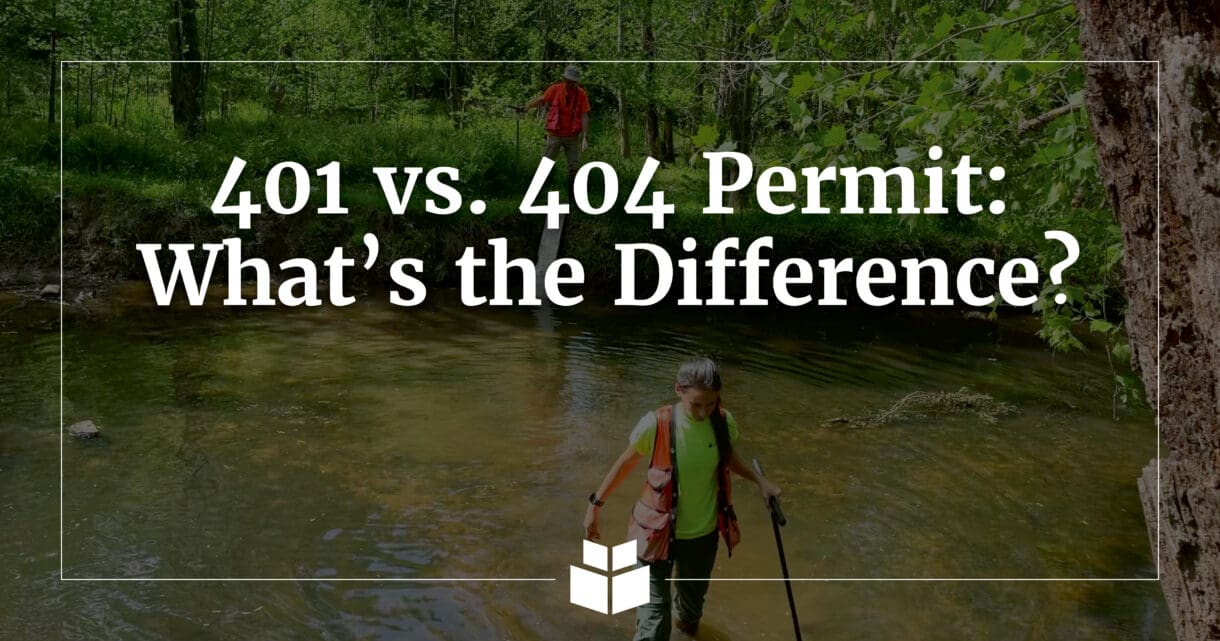
When planning a development project, navigating environmental permitting is a critical step, especially when your project may impact wetlands, streams, or other waters. Among the most frequently required permits are the Section 401 Water Quality Certification and the Section 404 Permit under the Clean Water Act. While these permits are often discussed together, they serve distinct purposes and are administered by different agencies. Understanding the differences between them can help ensure compliance and prevent costly project delays.
What is a 401 Water Quality Certification?
According to the North Carolina Department of Environmental Quality (NCDEQ), the 401 & Buffer Permitting Branch is responsible for implementing state water quality standards for lakes, ponds, streams, wetlands, and riparian buffers. Section 401 of the Clean Water Act requires applicants to obtain a Water Quality Certification from the state when a federally permitted activity may result in a discharge into waters of the United States.
In North Carolina, the 401 Certification ensures that a project will not violate state water quality standards, and it is often required alongside a Section 404 Permit. The NCDEQ evaluates the potential for adverse impacts to water quality and determines appropriate conditions or mitigation requirements.
What is a 404 Permit?
Section 404 of the Clean Water Act is administered by the U.S. Army Corps of Engineers (USACE) and regulates the discharge of dredged or fill material into waters of the United States, including wetlands and other special aquatic sites. This permit aims to protect aquatic environments while allowing reasonable development to proceed with proper oversight.
Depending on the scope of the project, the USACE may issue one of the following types of 404 permits:
- Nationwide Permit – For activities with minimal individual and cumulative environmental impacts.
- Regional General Permit – For specific categories of activities within a geographic region.
- Individual Permit – For projects with more substantial environmental impacts that require detailed review.
- Letter of Permission – For activities with minor impacts and little controversy.
The type of permit required is determined by the USACE based on project size, location, and potential environmental impact.
Key Differences Between 401 and 404 Permits
While 401 and 404 permits often go hand-in-hand, there are important distinctions between them:
-
Purpose:
-
401: Ensures compliance with state water quality standards
-
404: Regulates physical discharges of dredge or fill material into waters
-
-
Scope:
-
401: Focuses on water quality impacts within the state’s jurisdiction
-
404: Focuses on physical alteration of wetlands and waterbodies at the federal level
-
-
Trigger:
-
401: Required when any federal permit (like a 404) may affect water quality
-
404: Required for discharge of dredged/fill material into jurisdictional waters
-
How WithersRavenel Can Help
Expertise in Jurisdictional Determinations and the 401/404 Process
Wetlands, streams, and riparian buffers are present on many properties and can significantly impact the feasibility of a project. WithersRavenel offers comprehensive environmental due diligence services to help identify these features early and plan accordingly.
Services Tailored to Your Project Needs
-
Field Delineation and Mapping: Our team conducts on-site assessments to delineate wetlands and streams, followed by survey and mapping services to support permitting.
-
Permit Coordination: We prepare and submit permit applications and coordinate with agencies such as NCDEQ and USACE.
-
Endangered Species Reviews: We evaluate project sites for the presence of threatened or endangered species that may affect permitting decisions.
-
Buffer Compliance: For projects in regulated riparian buffer areas, we ensure full compliance with applicable rules.
Minimize Delays and Cost Overruns
Navigating the complex matrix of local, state, and federal regulations can be challenging. WithersRavenel’s deep understanding of environmental regulations allows us to propose alternative designs and permitting strategies that achieve your goals while staying compliant. This proactive approach helps our clients avoid unnecessary delays and budget surprises.
Our Environmental Services Include:
- Section 401 Water Quality Certification and Section 404 Permitting
- Wetland and stream delineation
- Threatened and endangered species evaluations
- Riparian buffer assessments and mitigation planning
- Regulatory agency coordination and compliance tracking
Understanding the distinctions between 401 and 404 permits is vital for any project that may impact wetlands, streams, or other waters. WithersRavenel’s experienced environmental consultants are here to guide you through the process, ensuring your project remains on schedule, on budget, and in compliance with both state and federal environmental laws.

